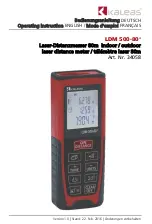
MI 2883 Energy Master
Theory and internal operation
149
5
6,0 %
3
5,0 %
2
2,0 %
7
5,0 %
9
1,5 %
4
1,0 %
11
3,5 %
15
0,5 %
6..24
0,5 %
13
3,0 %
21
0,5 %
17
2,0 %
19
1,5 %
23
1,5 %
25
1,5 %
5.2.5 Interharmonic voltage
The level of interharmonics is increasing due to the development of frequency
converters and similar control equipment. Levels are under consideration, pending more
experience. In certain cases interharmonics, even at low levels, give rise to flickers (see
5.2.7), or cause interference in ripple control systems.
5.2.6 Mains signalling on the supply voltage
In some countries the public distribution networks may be used by the public supplier for
the transmission of signals. Over 99 % of a day the 3 s mean of signal voltages shall be
less than or equal to the values given in the following figure.
Figure 5.17: Mains signalling voltage level limits according to EN50160
5.2.7 Flicker severity
Under normal operating conditions, in any period of one week the long term flicker
severity caused by voltage fluctuation should be
P
lt
≤
1 for 95 % of the time.
5.2.8 Voltage dips
Voltage dips are typically originated by faults occurring in the public network or in
network users installations. The annual frequency varies greatly depending on the type
of supply system and on the point of observation. Moreover, the distribution over the
year can be very irregular. The majority of voltage dips have duration less than 1 s and
a retained voltage greater than 40 %. Conventionally, the dip start threshold is equal to
















































